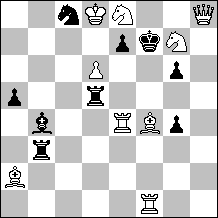Problem of the week -
Solutions
Horatio L. Musante
1st Prize Il Due Mosse 1952

#2 ( 9 + 9 )
1...e6 2.Rcxc8 #
1...e5 2.Sc7 #
There are mates ready for every move by black in the diagram position.
(1...Bb7/Sb~ 2. Rxd7/Sc3 #)
However, white have no waiting move. The solution changes the mates on the thematic moves
Solution:
1.Kb4 ! zz
The king is now exposed to checks by the BP/BB battery but it guards square c5, enabling mates by the white rook.
1...e6 + 2.Rc5 #
1...e5 + 2.Rd6 #
These are now two "cross-check" variations which are the line to the previous problem.
1...axb5 2.Qxb5 #
1...Bb7 2.Rxd7 #
1...Sb~ 2.Sc3 #
Comins Monsfield
1st prize American Chess Bulletin 1948

#2 ( 9 + 8 )
1…Bb3+ 2.Kxb3‡
1…Bxd5 2.Kc1‡
1…Bd3+,Qd3+ 2.exd3‡
1…Qd2+ 2.Kxd2‡
1…Qd1+ 2.Kxd1‡
1…Qc3+,Qxd5 2.K(x)c3‡
1…Qb2+ 2.Kxb2‡
The problem presents an intensive combination of "cross-checks" and half-pin. Cross-check is a term given for a check answered by check (mate in our case).
As can be seen, there are two variations with duals. Are these serious duals? Can they be prevented?
The half-pin is the link to the previous problem.
1…Qe3,Qg1,Qa1 2.Rd8‡
1…Rxa8 2.Qxh1‡
(1…Qe5 2.Kc1,Kd1,Kd2‡
1…Qf2 2.K~,Rd8‡)
Herbert Ahues
1st Prize Die Schwalbe 1948

#2 ( 9 + 10 )
1…Bf1 2.Be5‡
1…Be6! 2.Qd6‡
This is a "correction" move. It prevents the mate 2.Be5# by cutting of the white queen guard on f5 while 2.Be5 cut the guard of the white rook on f5. But this defense interferes with black rook h6 and allows 2.Qd6#
1…Bxf2 2.Sd5‡
1…Bf6! 2.Sce6‡
Again a correction move. 2.Sd5# is prevented since e5 will not be guarded, again by cutting off lines by both black & white. Again we have interference with rook h6 which enables the mate.
The different ways the defenses work should not be missed.
1…Sf5+,Sxh1 2.Q(x)f5‡
So the themes of this problem are the half-pin combined with the interferences which are the link to the previous problem.
Jacques Savournin
1st Prize The Problemist 1960

#2 ( 6 + 9 )
1.Bf6? [2.Qc8,Sd6#] but 1…Bxf7+!
A random move by the white bishop threatens 2.Qc8# but white must cope with black's move 1...Rc6. A direct interference on f6 also interferes with the white queen but an "indirect" interference on c7 works. This is called "white correction"
1.Bc7! [2.Qc8#]
1…Re6 2.Rf8#
1…Be6 2.Sd6#
Grimshaw interferences: the defense with the rook is an unpis.
1…Sfe6 2.Re7#
1…Sce6 2.Qb5#
Two additional interferences one of them unpin.
In total we have two unpin interferences of the bishop and two interferences of the rook.
1…Sxb7,Sd7 2.Q(x)d7#
1…Bxf7+ 2.Qxf7#
1…Rd6 2.Sxd6#
And the link to the previous problem is the interferences.
Milos Tomasevic
3rd Prize Sahovski glasnik 1955

#2 ( 11 + 9 )
1…Sb5 2.c3#
1…Sb3 2.c4#
These two variations show battery interference mate after interferences by black
1…Rd3,Bd3 2.exd3#
1…Rxf3,Sxf3 2.exf3#
More pawn battery mates
1…Sf5 2.Qg4#
1…Sc6 2.Sd6#
1…Se6 2.Qxh7#
Subtle interferences - white must chose the mates very carefully.
1…Rb4 2.Sd6#
1…Qc5,Qc4,Qc3 2.Qg4#
The link to the previous problem is the four pawn battery mates, this time by two different batteries.
Jean Oudot
Le Probleme 1949

#2 ( 11 + 3 )
Excellent key providing 2 flights
1…Rxb3+ 2.cxb3#
1…Rc4 2.c3#
1…Rxc5 2.c4#
1…Rxd3 2.cxd3#
These four variations show the Albino theme: all 4 possible moves of a white pawn.
1…Rxc2 2.Rxc2#
1…Kd2 2.Qd1#
1…Kf2 2.Qf1#
A pleasing problem and the link to the previous one are the four mates by a single battery
Lev Loshinsky
1st Prize Russian Committee of Sports T.T. 1953

#2 ( 9 + 9 )
1.Qh7! [2.Se6#] The key provides a flight and the threat is a battery mate harmonizing with the main content.
1…Rh5 2.Bg5#
1…Rh3 2.Bg3#
Half-pin with battery interferences of the rooks that moved beyond a critical square,
1…e5 2.Be3#
1…Bc3 2.Be5#
Here we have self-interferences matched by battery interferences.
These completes a "Bishop star"
(1…Rxd6+/ 2.Bxd6/Bxe5#)
The connection to the previous problem is easy: the half-pin.
Loric Bata
1st Prize Sahovski vjesnik 1951-2

#2 ( 11 + 7 )
1.Qa2! [2.Qb1#]
Elegant long key - note how other places for the queen, like b3 or c4, are prevented.
1…Rc5 2.Sd6#
1…Rc6 2.Qd5#
In these two variations we see a combination of half-pin and interferences
1…Rf2 2.Qe6#
1…Rxg2 2.Qxa8#
In these two variations the unique mates are enforced by the flight (free square for the king) given by the defences.